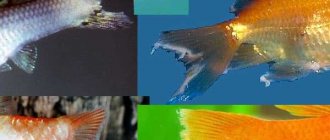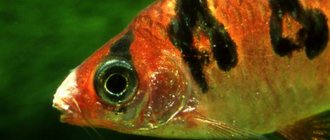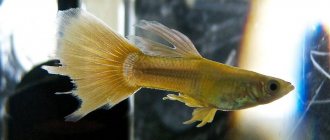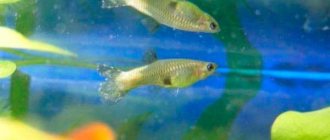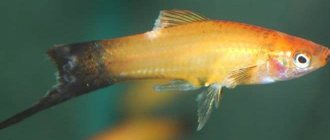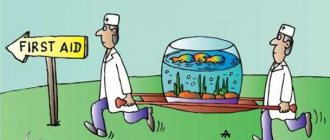Why do fish start to die?
Newbie mistakes lead to the death of fish. The most common ones are listed below.
Water pollution
Guppies die from contamination in the aquarium, which causes disease, poisoning and lack of oxygen. The liquid must be free of impurities and dechlorinated.
Nitrogen poisoning
When poisoned by nitrogen compounds, the fish's eyes bulge and it shows signs of oxygen starvation. Increase aeration and replace up to 40% of the liquid. Find out how much the concentration of nitrogen compounds in the water is and neutralize the excess using conditioners.
Water temperature
If guppies are kept at inappropriate temperatures (22-28 degrees), they are susceptible to disease. A sudden change in temperature leads to temperature shock and death.
Incorrect launch of fish
Neglecting quarantine when introducing a new fish can lead to the fish dying one by one. The new fish should be observed in a separate container for at least 3-4 weeks, and only if there are no diseases can it be placed in a common aquarium. It is also necessary to gradually adapt newly acquired fish to the conditions of a particular aquarium. Do not release the fish from the bag into the aquarium immediately; add new water little by little every 15–20 minutes.
Fish diseases
Diseases are a common cause of death. Observe the behavior and appearance of the fish, do not delay treatment if you suspect a disease.
Water quality
The quality of the water environment is declining due to:
O2 deficiency
Lack of oxygen occurs when there is overcrowding. Guppies concentrate at the surface of the water and greedily swallow air. Connect the compressor. Remember that in summer, oxygen consumption increases due to rising temperatures. Turn off the lamp and cool the water by immersing bottles and ice packs in the aquarium.
Aggressive neighbors
Harassment from neighbors is another cause of death for guppies. Incorrect compatibility leads to injury and severe stress. Aggressive neighbors can chase the fish to death and even eat it.
Acclimatization
Not all guppies can survive adaptation to new conditions and transportation. Old and weak fish often die, even if the aquarist has caused little concern to the pets.
Video
Impaired coordination of movement in aquarium fish. Malawian cichlids
WHAT IF you pull a turtle out of its shell / OPENING UP A DEAD TURTLE
FISH WHO ARE TIRED OF LIVING IN THE WATER!
The Hole Is Eating My Face (Full Episode) | Speak Ukraine
Diseases
The list of diseases of aquarium fish is huge; experienced aquarists and people with special education understand them. If you lack experience, it is better to consult a doctor.
Fin rot
The disease appears in dirty water when the fins are injured. If you ignore the disease, after the destruction of the fins, damage to the body will begin and the fish will die. Fin rot is treated:
There are many methods for treating fin rot. The treatment is discussed in detail in a separate article.
Plistophorosis
The disease is also called “neon disease” and pleistophorosis. The fish's muscles are affected and ulcers appear on the body. Plistophorosis cannot be treated; the diseased individual must be destroyed. Boil the soil and decor, rinse the aquarium.
Red scab
The disease most often affects males. Remove the parasite-affected areas of the fins with a blade. Place the guppies in salted water (1 g salt per 1 liter). Treat in combination with levomycin (1 tablet per 30 l) or furazolidone (0.5 tablets per 10 l). The course of treatment is 5 days. Remedies for ichthyophthyriosis also help. The tail grows back after some time.
Scoliosis
If the spine is curved, and no other symptoms of disease are observed, then the curvature may be congenital. Individuals with scoliosis can lead normal lives, but they are smaller and weaker than healthy guppies. Scoliosis that appears in an adult fish can be corrected by reducing portions during feeding and introducing variety into the diet. During pregnancy, the female monitors the aeration in the aquarium and does not allow inbreeding.
Tetrachymenosis
The ciliates Tetrahymena infect the gills and fins. Place the sick fish in salted water (1 g of salt per 1 liter) with increased aeration. Add a solution of biseptol (1 tablet per 50 liters of water) or furazolidone (0.5 tablets per 10 liters) into the water. Prevent healthy fish by mixing a small amount of furazolidone with food.
Tuberculosis or mycobacteriosis
In addition to weight loss and curvature of the spine, there is a fading of color. Treatment is possible in the early stages; a number of aquarists consider the disease incurable. Place the fish and add kanamycin (30–50 mg per liter) to the water daily for 10–14 days with daily water changes. You can soak the food in a solution of kanamycin (0.5 g of the drug per 100 ml of water). Another method: adding isoniazid (1 tablet per 60 l) for 3 days. Then a break is taken for 2 days. The course is repeated 2-3 times. After transplanting the sick fish, disinfect the aquarium, wash the decorations and boil the soil.
Dropsy ascites
In addition to the abdomen, fish have enlarged eyes. Guppy tends to hide and spend more time at the bottom. Dropsy appears for various reasons:
Treat dropsy with frequent changes and adding salt to the water (1 tablespoon of salt per 10 liters). Put your guppy on a hunger strike for a couple of days and review its diet. Increase aeration and add antibacterial drugs, for example, chloramphenicol (mix 250 mg of the drug with 25 g of feed or 10 mg per 1 liter of water).
Trichodinosis
The parasitic disease is most dangerous for fry. Damage to ciliates begins with the fins, and in the last stages the gills are affected. Raise the temperature and increase aeration. For every 10 liters of water add 1 tbsp. l. salt. Use malachite green or methylene blue in proportions of 5 ml per 10 liters of water.
Columnaria
Advanced disease is accompanied by ulcers. You can cure it with bicillin-5 (one-third of a bottle per 100 liters of water, shade the aquarium during exposure) and methylene blue (5 ml per 10 liters of water).
Ichthyophthiriasis (semolina)
Carry out treatment in salted water (1 teaspoon per liter of water) with an increase in temperature by 2-3 degrees. Use biomycin and trypaflavin, course of treatment for 2 weeks. You can read more about the disease ichthyophthyriosis in another article.
Oodiniumosis
“Velvet rust” is treated with copper sulfate (0.2 mg per 1 liter of water) with an increase in temperature. If oodiniumosis is not completely eliminated, repeat treatment after 2–3 days.
Costiosis
In addition to plaque and inhibited behavior, the disease is characterized by protruding, pale gills. In the early stages, treat costosis with malachite greens in accordance with the instructions. Salt baths with potassium permanganate (1 teaspoon of salt per 1 liter of water, potassium permanganate until slightly pink) for 10–15 minutes are effective.
Hexamitosis
Spironculosis, octomitosis or hole disease is a rare disease for guppies. It is treated with metronidazole (250 mg per 35 liters of water) with water changes.
Hermaphroditism
It cannot be treated and is not noticeable externally. Self-fertilization rarely occurs in females, and the offspring are infertile.
Non-infectious
These fish diseases are not transmitted from sick individuals to healthy ones and are caused by improper care or improper living conditions.
Chlorine poisoning
The cause of the disease is keeping fish in water with a high concentration of chlorine. Poisoned pets experience weakness, lethargy and pale gills. The fish try to jump out of the aquarium and, if the owners do not act, they can die.
General treatment recommendations
Chlorine poisoning is treated by moving the fish to a tank with clean water. To prevent the occurrence of disease, the aquarium should be filled only with settled liquid passed through a carbon filter.
Acidosis or acid disease
It develops as a result of a sharp drop in pH levels and is accompanied by a decrease in the activity of fish and the appearance of white spots on their scales. Individuals that have died from acid disease have closed gills and curled bodies.
General treatment recommendations
Acidosis is treated by normalizing the acidity of the water by adding soda.
Acidemia or ammonia poisoning
The disease affects fish living in overcrowded tanks with water saturated with waste. In individuals affected by ammonia poisoning, darkening of the scales is observed, and in rare cases, injuries to the gills. The fish swim at the surface of the water and try to jump out of the aquarium.
General treatment recommendations
Acidemia is treated by replacing half the volume of water, increasing filtration and thoroughly cleaning the aquarium from dirt.
Alkalosis or alkaline disease
The development of alkaline disease in aquarium fish occurs under the influence of an overly acidic or soft water environment. It is accompanied by a decrease in color intensity and the disappearance of natural shine. Sick fish become overexcited and behave very unusually. Their fins spread out and mucus is abundantly secreted from their gills.
General treatment recommendations
Alkalosis is treated by restoring the acid balance of the aquatic environment. The fish are moved into a tank with a pH of 7.0-8.5. If this is not done, the disease will progress and can lead to blindness due to clouding of the eyes or death of pets.
Asphyxia or suffocation
The disease occurs due to exposure to water depleted of oxygen. The fish keeps its gills open and makes active breathing movements.
General treatment recommendations
To cure asphyxia, the fish is transplanted into an aquarium, the water in which is well saturated with oxygen.
It is important! Symptoms of suffocation are similar to those of many infectious diseases. If, after moving the fish to a new tank, its condition has not improved, it is worth clarifying the diagnosis.
Argulez
This fish disease is caused by fish louse or carp-eating crustaceans. These parasites with a fairly large rounded body can be seen with the naked eye. Fish affected by them develop wounds from which bloody mucus is released. Sick individuals refuse to feed, rub against hard surfaces, or sway. The carp eater, which penetrates the fish's body, injures the skin and muscles and releases a toxin into the blood.
General treatment recommendations
The affected fish is caught from the water and the parasite is pulled out of its body using tweezers. Then the wound is disinfected with a solution of potassium permanganate.
Inflammation of the gastrointestinal tract
Inflammation of the digestive system is a consequence of consuming low-quality or too hard feed. The disease is accompanied by fading of color, weakness, apathy and thread-like feces mixed with mucus or blood.
General treatment recommendations
Inflammation of the gastrointestinal tract is treated with a two-day starvation diet, followed by transferring the fish to a high-quality and balanced diet.
Gas embolism
The cause of this fish disease is considered to be blockage of blood vessels by air bubbles, which occurs when kept in water supersaturated with oxygen. The affected individual becomes restless and anxious. Her gill tissues darken, her eyes become cloudy, and swelling appears.
General treatment recommendations
Gas embolism is treated by transplanting the fish into a container with normal water.
Cold
The disease develops when kept in insufficiently warm water and is accompanied by lethargy, pale color, swelling and paleness of the gills. Cold fish sway and stay near the surface of the aquarium.
General treatment recommendations
Colds are treated by increasing the water temperature to the values recommended for a specific type of fish.
Mechanical injuries
If neighbors are selected incorrectly, conflicts often break out between fish, ending in fights. The result of such collisions is injuries. Also, fish can get injured on the sharp corners of the decorations in the aquarium.
General treatment recommendations
When injuries appear on the body of the fish, the cause of the injury is removed from the aquarium, and the wounds themselves are treated with baths with potassium permanganate or methylene blue.
Anoxia
The disease occurs due to lack of air and can lead to the death of fish. Affected individuals become restless and swim near the surface of the water.
General treatment recommendations
Treatment of anoxia comes down to restoring the oxygen balance in the aquarium by increasing aeration or adding hydrogen peroxide to the water.
Gonadal cyst
A sick fish loses its appetite, develops infertility and develops a tumor, leading to a bloated abdomen. Gonadal cysts cannot be diagnosed early and inevitably lead to the death of the pet.
Obesity
A sick fish's blood becomes lighter, its abdomen swells, and fatty tissue forms on its internal organs. Obesity cannot be cured, but it can be prevented by properly organizing your diet.
Bug-eyed
Unilateral exophthalmia develops as a result of eye injury, bilateral exophthalmia is caused by a bacterial infection. One or both eyes increase in size and become cloudy, and in case of mechanical damage, blood appears in them.
Frozen fish
Temperature
The temperature of the refrigerator in which frozen fish is stored should not exceed –18 °C. Depending on the type and storage conditions, fish can be suitable for consumption from a month to a year.
Appearance
If the product is packaged, touch it. Several fish in one bag should be whole, not stuck together. Slightly thawed fish is sometimes re-frozen. The smell of old fat may indicate this. Fish will not lose its properties if it is slowly defrosted and frozen in a quick, shock way. But the danger is that the seller could violate the freezing rules.
Infectious diseases
This is a group of diseases caused by microorganisms and transmitted from one individual to another.
Branchiomycosis (gill rot)
The causative agents are fungi that settle on the gill filaments. Branchiomycosis is characterized by rapid development; weakened fish often become ill with it.
Symptoms:
- lack of appetite;
- oxygen deficiency;
- change in the shape of the gill covers;
- apathy;
- hemorrhages on the gill filaments;
- the fish can swim on its side.
As soon as the first symptoms appear, the pets are transplanted into a separate container and treated with fungicidal preparations, and the main aquarium is cleaned and disinfected.
Hexamitosis
The causative agent is hexamita trutte. It is an intestinal parasite called a flagellate. It gets into the aquarium with low-quality food, soil, vegetation or other fish that are carriers.
Symptoms:
- exhaustion with good appetite;
- inflammation of the anus;
- white excrement;
- destruction of fins;
- the appearance of holes on the head.
Hexamitosis in Astronotus
The fish are transferred to a separate aquarium and the temperature is increased for a couple of days, providing air ventilation.
Metronidazole is also a proven remedy. The solution is added to the aqueous medium in a ratio of 0.25 mg per 20-25 liters of water. The medicine is administered every day at the same time for three days.
We recommend reading the article: Hexamitosis in aquarium fish: causes of occurrence, treatment of the disease
White-skinned
The causative agent of this infectious disease is the bacterium Pseudomonas dermoalba. Enters the aquarium with a sick individual or infected objects.
Symptoms:
- whitening of the skin around the tail and dorsal fin;
- pale color;
- swimming near the surface with the dorsal fin sticking out of the water.
For therapy, pets are sent to a container with chloramphenicol. The viewing aquarium is disinfected.
Fin rot
The causative agent is pseudomonas. The development of the disease is associated with insufficient care and infrequent water changes. Occurs in neon, labyrinth species, barbs, guppies, goldfish and angelfish. The fry suffer the most.
Symptoms:
- barely noticeable white-blue clouding of the fin edges and sometimes the cornea of the eyes;
- red stripes appear on the fins;
- the fin edges become disheveled, the ends of the fin rays fall off
- Light-colored ulcers appear on the body when the condition is neglected.
Fin rot in Cockerel
To stop the disease, care must be taken to improve the maintenance of the fish. If the fins are severely affected, medications are used. Arrange a therapeutic bath in a separate vessel. In addition, the main vessel, soil, and equipment are systematically disinfected. Aquarium plants are disinfected with bicillin-5.
We recommend reading the article: Causes of fin rot, treatment in a community aquarium
Mycobacteriosis (Tuberculosis)
This disease affects mainly viviparous fish. The causative agents are mycobacteria that enter the aquarium with food, soil, plants or new infected aquarium inhabitants. Improper living conditions can contribute to the development of the disease.
Symptoms:
- violation of orientation in space;
- lack of appetite;
- lethargy;
- fins are destroyed, scales fall out;
- Some fish develop ulcers, abscesses, and bulging eyes; others develop black spots on the skin, bones protrude, and vision is severely affected, even leading to blindness.
Mycobacteriosis can be cured only at the initial stage with the help of trypoflavin and monocycline.
Plistophorosis (Neon disease)
It is caused by an amoeboid sporozoan, which parasitizes the muscles of the body and head of the fish. It is a round nodular formation. Infection occurs from poor-quality soil, food or an infected aquarium. The characin family is most susceptible to the disease.
Symptoms:
- the fish move spasmodically;
- lack of coordination;
- lack of appetite, exhaustion;
- fading of color;
- pets swimming at the surface upside down;
- the fish stay apart and do not flock together.
Plistiphorosis cannot be treated, so you need to kill the diseased individuals, thoroughly clean and disinfect the aquarium.
Peptic ulcer
The causative agent is a fluorescent pseudomonas. Entering a container with food or from infected individuals, it parasitizes the epithelium of the infected person.
Symptoms:
- dark spots on the skin, which over time turn into ulcers;
- bulging eyes;
- scale damage;
- abdominal enlargement;
- loss of appetite.
For therapy, streptocide (1 tablet/10 l) or potassium permanganate is used. Treatment is carried out in a common aquarium.
We recommend reading the article: Bug-eyed aquarium fish
Dermatomycosis
The causative agent is the mold fungus saprolegnia. Settles on open wounds and ulcers of aquarium fish.
Symptoms:
- cotton wool-like coating of a whitish or yellowish tint;
- shortening, gluing, destruction and even falling off of fins;
- apathy and immobility.
If another disease is detected in the fish and saprolegnia has settled on it, it is necessary to diagnose it and prescribe adequate treatment. Plaque is removed from the sores using tweezers. As soon as the fish recovers, the fungus will disappear on its own. If it occurs on the mucous membrane, the pet is placed in a separate container, adding a malachite green solution or formaldehyde.
It is important not to damage the mucous membrane. In addition, you need to disinfect the water with UV rays.
Ichthyophonosis
The causative agent is the fungus ichthyophonus. External signs of the disease are similar to mycobacteriosis. A fungus that has settled on any organ causes inflammation, severe enlargement, and then scars appear.
Symptoms:
- lack of coordination, slow swimming, sometimes pets lie on the bottom and move jerkily;
- loss of appetite, exhaustion;
- bulging eyes;
- raising scales;
- fin tremor;
- darkening of color;
- the occurrence of ulcers.
External symptoms can sometimes be subtle or completely absent.
Ichthyophonosis cannot be treated, so sick fish will have to be killed. The rest are placed in a separate container, and the main one, where the infected individuals were, is thoroughly disinfected. The soil and equipment are boiled.
Lepidorthosis
The disease is caused by the bacteria Aeromonas punctata and fluorescent pseudomonas. Diseased individuals who have not undergone quarantine serve as carriers.
Symptoms:
- ruffling of scales, which at first rises only in some places, and then throughout the body;
- at an advanced stage – loss of scales.
An infected fish can only be cured at an early stage. Make therapeutic baths in a separate container using streptocide, bicilin-5. If therapy does not produce results, the pets are killed and the aquarium with equipment is disinfected.

